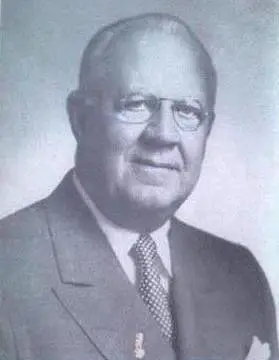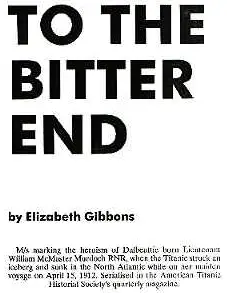19. No. 7 - Men Allowed
On the starboard boatdeck, Murdoch and a party of men were readying the first starboard lifeboat when First Class passenger W. T. Sloper arrived with his bridge partners, American cinematograph star Dorothy Gibson, her mother, and another man from First Class, Frederick H. Seward. Sloper would live to write what he observed in The Life and Time of Andrew Jackson Sloper: Sketch Number Twelve: My Eye Witness Story of the Titanic Disaster (1949). His party stood in the shelter of the superstructure with some 50 or 60 other passengers, adjusting lifebelts, trying to hear over the roar of the steam. According to Sloper, Murdoch, shouting through a megaphone, then announced:
"Any passengers who would like to do so may get into this life boat. There will be no difficulty launching it as the sea is perfectly calm. Later, after we have had a chance to find out how much damage has been done to the ship, we will pick you up again."
Murdoch knew there was no return to the Titanic, but the choice of words was classic company policy and perfectly fitted Captain Smith's known method: no disorder and no panic. Sloper saw a few passengers between his party and the boat "handed down into the life boat by him [Murdoch] and his assistants" and saw others decline and step back onto the deck. There was no pushing or jostling; everyone, he wrote, "seemed to have taken a firm grip on his nerves". Only Dorothy Gibson did not conform to decorum: she became hysterical.

First class survivor William Thompson Sloper
(1883-1955). His experience was detailed in a
portion of the book "The Life and Times of
Andrew Jackson Sloper, 1849-1933."
(Source: Find A Grave)
Sloper did not grasp the contradiction: why would anyone need firmly gripped nerves if they could infer from what the First Officer had just said assuming that he was heard correctly that the danger might not be too great? Like Third Officer Pitman, the passengers milling about might have felt that the ship was safer than an open boat.
Those who elected not to stay were handed in by Murdoch and his men without distinction. Whatever Captain Smith's orders may have been regarding women and children, Murdoch, for the remainder of the night, merely gave preference to women and children, allowing men to board whenever the supply of ladies dwindled. As late as the loading of No. 13, lowered at approximately 1:25 am, Murdoch was still admitting men wherever possible. Second Class passenger Rev. A. F. Caldwell of Roseville, Illinois, who left in No. 13, remembered Mrs. Caldwell asking "can't my husband come, too?" Mrs. Caldwell was the last woman boarding, and Rev. Caldwell was promptly allowed to come too, followed by all those men standing by who wished to do so. Able seaman George McGough would state in New York that Murdoch supervised loading the lifeboats, with the cry "Ladies, this way", but that men were put in for lack of response by women and children. That Murdoch was permitting men to enter (and possibly intentionally not noticing those who stepped into the early boats without express command) is made clear by the testimony of Boatswain's mate Albert Haines, who left in command of No. 9:
Senator Smith: Did the men passengers try to get into the boats?
Mr. Haines: No, sir; I did not see any of them do it, at least.
Senator Smith: Were they told to stand back?
Mr. Haines: Yes.
Senator Smith: By Officer Murdock?
Mr. Haines: Yes, sir.
Senator Smith: What did he say when he told them that?
Mr. Haines: He just stood there; that is all.
Senator Smith: What did he say?
Mr. Haines: He filled the boats with the ladies. He told me to put all these ladies in the boat, and he filled her up, sir. When she was full two or three men jumped in the bow of her. He said, 'That is enough,' and he lowered her down" (Pages 661-662)
If Sloper is accurate, however, Murdoch had called for any available passenger at the very first occasion. Sloper and Seward themselves left in this first boat. Miss Gibson had a firm grasp on her escort, insisting that the men come, and solely to humor her they did so. Sloper claimed that Murdoch personally assisted him and Steward into the boat. In the next ten minutes, a further handful of people boarded. Murdoch then asked: "Are there any more who would like to get into this boat before we lower it away?" No one got in.
Seward and Sloper were not the only men in the first boats. Mr. and Mrs. Dickinson H. Bishop of Dowagiac, Michigan, both of whom testified before the Senate, had arrived at the propitious moment. Helen Bishop:
Mrs. Bishop: We had no idea that it was time to get off, but the officer [Murdoch] took my arm and told me to be very quiet and get in immediately. They put the families in the first two boats. My husband was pushed in with me, and we were lowered away with 28 people in the boat.
. . . . .
Senator Smith: How many women were there?
Mrs. Bishop: There were only about 12 women.
Senator Smith: And the rest were
Mrs. Bishop (interposing): Were men." (Page 999)
Mrs. Bishop stated there were three crew members, the remaining thirteen men all passengers:
Thirteen passengers; yes. Among those there were several unmarried men in our boat, I noticed, and three or four foreigners in our boat." (Page 999)
Dickinson Bishop followed his wife to the witness stand:
Senator Smith: Did you hear any order given by anyone for the men to stand back?
Mr. Bishop: I heard no such order.
Senator Smith: 'Women first,' or 'Women and children first'?
Mr. Bishop: No.
Senator Smith: At the time the first lifeboat was lowered, are you willing to say that that order had not been made?
Mr. Bishop: Absolutely.
. . . . .
Mr. Bishop:. . . . I would like to revise that statement I just made, in a way, about the order 'Women first.' I can say positively there was no such order given on the starboard side, near where our boat was lowered. What happened on the port side I knew nothing of, at all." (Page 1,003)
Bishop was fortunate not to have been near Lightoller to find out, or he would not have gone into history as a Senate witness. Bishop described entering No. 7:
Senator Smith: Who told you to get into the lifeboat?
Mr. Bishop: One of the [senior] officers in charge of the lowering; which one, I could not tell. There was some confusion there at the time, and I did not pay much attention. There was an officer stationed at the side of the lifeboat, and as my wife got in I followed immediately, and he helped me into the boat, or rather indicated, and I fell into the boat." (Page 1,002)
It was Murdoch who had indicated. Dickinson Bishop was not a man who needed two hints; he sat down beside his wife and kept quiet, resulting in what is known as a respectable old age.
Mrs. Bishop thought there were 28 people in No. 7, perhaps a few more. W. T. Sloper thought there were only 19. It was designed to hold approximately 65. Why Murdoch ordered it lowered with so few is inexplicable, except in connection with his intention of evacuating further passengers from the gangway doors aft once the boats were launched. One of the gangway doors still remains open, but no one ever went through it to the safety of a lifeboat.
